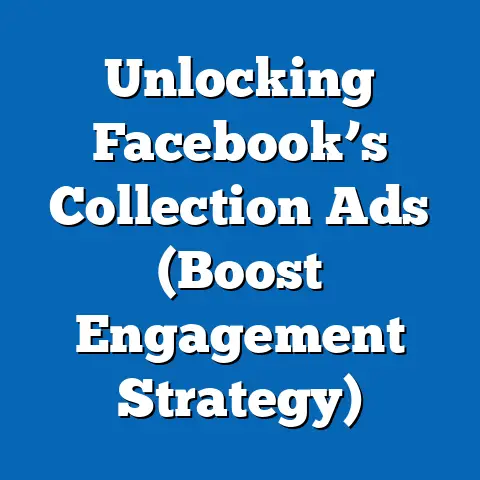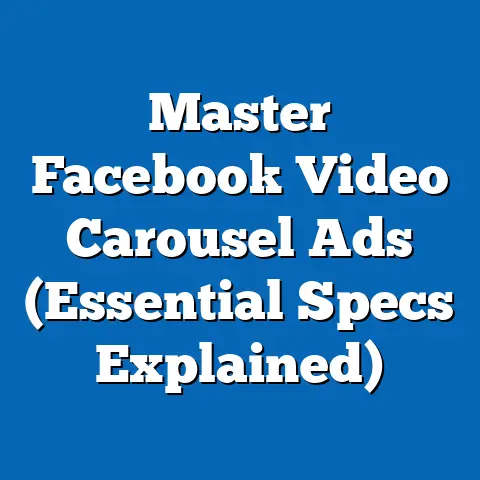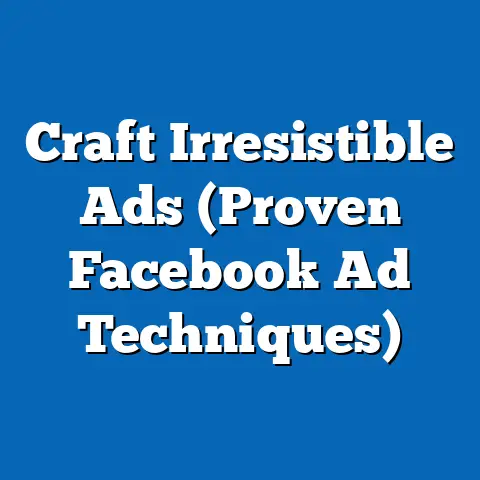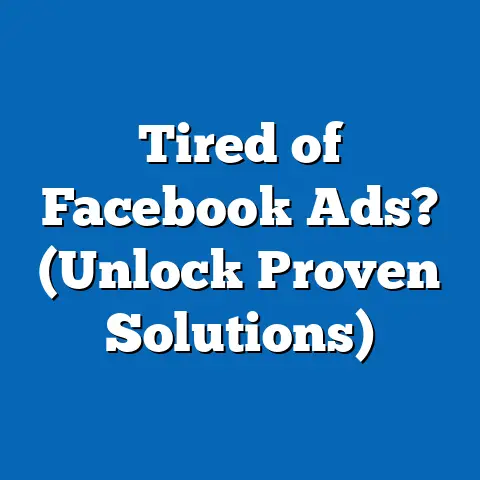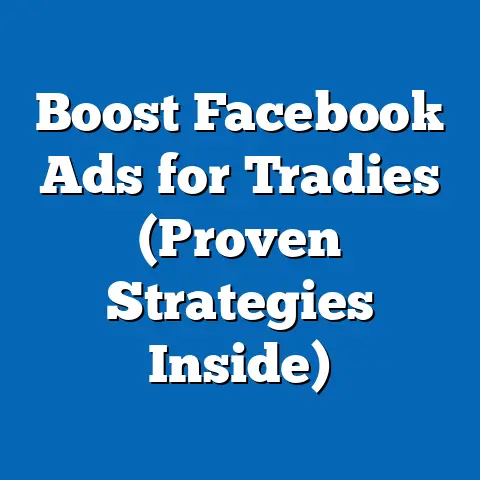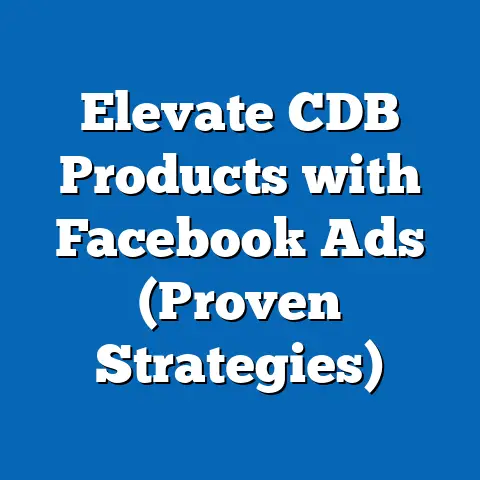Master Facebook Ads for Instagram Success (Proven Strategies)
Imagine Facebook ads as a sturdy bridge. This bridge connects your business to the vibrant, visually-driven world of Instagram. When built correctly, this bridge doesn’t just span the gap; it transports your brand across the chasm of obscurity, straight into the heart of customer engagement and sales. In today’s digital landscape, understanding how to construct and maintain this bridge is paramount. It’s about more than just placing ads; it’s about crafting a cohesive strategy that leverages the strengths of both Facebook and Instagram to achieve your marketing goals.
I’ve spent years navigating the intricacies of Facebook and Instagram advertising, and I’ve seen firsthand the power of a well-executed campaign. I’ve also witnessed the frustration of wasted ad spend when strategies are poorly planned or implemented. That’s why I’m passionate about sharing proven strategies that can help you build a robust and effective “bridge” to Instagram success.
This guide will walk you through the essentials, from understanding the advertising landscape to crafting compelling content, setting realistic budgets, and continuously optimizing your campaigns. Let’s get started!
The Landscape of Facebook and Instagram Advertising
Before diving into specific strategies, it’s crucial to understand the lay of the land. Facebook and Instagram, while distinct platforms, are deeply intertwined within the Meta advertising ecosystem.
Overview of Facebook and Instagram as Advertising Platforms
Facebook, with its massive user base and sophisticated targeting capabilities, forms the foundation of this ecosystem. It allows you to reach a broad audience based on demographics, interests, behaviors, and more. Think of it as the main highway leading to your destination.
Instagram, on the other hand, is the scenic route. It’s a visually-driven platform where users come to discover and engage with captivating content. Advertising on Instagram allows you to tap into this highly engaged audience, showcasing your brand through stunning visuals and compelling stories.
- Significance of Facebook’s Ad Ecosystem: Facebook’s ad platform is incredibly powerful, offering granular targeting options, detailed analytics, and a wide range of ad formats. It’s the engine that drives your advertising efforts across both platforms.
- Current Statistics: Did you know that as of 2023, Instagram boasts over 2 billion monthly active users? And that a significant percentage of these users discover new products and brands through the platform? These numbers underscore the immense potential of Instagram advertising.
- Unique Advantages of Instagram: Instagram’s visual nature makes it ideal for brands that can showcase their products or services through compelling imagery and video. The platform’s focus on storytelling also allows you to connect with your audience on a deeper, more emotional level. The engagement rate on Instagram is also generally higher than on Facebook, meaning your ads have a better chance of capturing attention.
Takeaway: Facebook provides the robust targeting and infrastructure, while Instagram offers the visually engaging environment. Understanding their individual strengths is the first step to creating a successful campaign.
The Importance of a Cohesive Strategy
Trying to manage Facebook and Instagram ads as separate entities is like trying to build a bridge with mismatched parts. To truly maximize your advertising ROI, you need to develop a cohesive strategy that integrates both platforms.
- Unified Strategy: A unified strategy ensures that your messaging and branding are consistent across both platforms. This helps to build brand recognition and trust with your audience.
- Cross-Platform Retargeting: One of the most powerful benefits of a cohesive strategy is the ability to retarget users across both platforms. For example, you can show an Instagram ad to users who visited your website after seeing a Facebook ad. This allows you to nurture leads and move them further down the sales funnel.
I remember working with a client who initially treated their Facebook and Instagram ads as separate projects. They were running different campaigns with different messaging and targeting. Once we integrated their strategy, aligning the messaging and leveraging cross-platform retargeting, we saw a significant increase in conversion rates and a decrease in overall ad spend.
Takeaway: Don’t silo your Facebook and Instagram ads. Develop a unified strategy that leverages the strengths of both platforms to achieve your marketing goals.
Understanding Your Audience
You can’t build a bridge to nowhere. Before you start crafting your ads, you need to understand who you’re trying to reach on Instagram.
Defining Your Target Audience
Identifying your target audience is the cornerstone of any successful advertising campaign. Facebook’s Audience Insights tool is an invaluable resource for this.
- Audience Insights: This tool allows you to explore the demographics, interests, and behaviors of people on Facebook and Instagram. You can filter by location, age, gender, interests, and more to get a detailed picture of your ideal customer.
- Customer Personas: Creating customer personas is another effective way to define your target audience. A persona is a fictional representation of your ideal customer, based on research and data. Give your persona a name, a job, a family, and a set of goals and challenges. This will help you to better understand their needs and motivations, and to craft ads that resonate with them.
I find that focusing on the “why” behind your target audience’s behavior is more effective than just knowing the “what.” For example, instead of just knowing that your target audience likes hiking, try to understand why they like hiking. Are they seeking adventure? Are they looking to connect with nature? Understanding the underlying motivations will help you to craft more compelling ads.
Takeaway: Use Audience Insights and customer personas to develop a deep understanding of your target audience. The more you know about them, the more effective your ads will be.
Analyzing Audience Behavior
Once you’ve defined your target audience, it’s time to analyze their behavior on Facebook and Instagram.
- Facebook Analytics: Facebook Analytics provides valuable insights into how users interact with your content. You can track metrics like page views, post engagement, and website traffic to understand what resonates with your audience.
- Engagement Metrics: On Instagram, pay close attention to engagement metrics like likes, comments, shares, and saves. These metrics provide valuable clues about the types of content that your audience finds most appealing.
I often advise clients to experiment with different types of content and to closely monitor the engagement metrics. Don’t be afraid to try new things and to adapt your strategy based on what you learn. For example, if you notice that your video ads are performing particularly well, you might want to invest more in video content.
Takeaway: Use Facebook Analytics and Instagram engagement metrics to understand how your audience interacts with your content. This will help you to refine your strategy and to create ads that resonate with them.
Crafting Compelling Ad Content
With a solid understanding of your audience, you’re ready to create ads that grab their attention and drive results.
Visual Storytelling
Instagram is a visual platform, so the quality of your visuals is paramount.
- High-Quality Visuals: Use high-resolution images and videos that are visually appealing and relevant to your brand. Invest in professional photography or videography if possible.
- Engaging Storytelling: Tell a story with your visuals. Show your product or service in action, and highlight the benefits it provides.
- Successful Ad Formats:
- Carousel Ads: These allow you to showcase multiple images or videos in a single ad. They’re great for telling a longer story or for showcasing a range of products.
- Video Ads: Video ads are highly engaging and can be used to capture attention and convey complex information in a short amount of time.
- Instagram Stories Ads: These ads appear between users’ Stories and offer a highly immersive and engaging experience.
- Carousel Ads: These allow you to showcase multiple images or videos in a single ad. They’re great for telling a longer story or for showcasing a range of products.
- Video Ads: Video ads are highly engaging and can be used to capture attention and convey complex information in a short amount of time.
- Instagram Stories Ads: These ads appear between users’ Stories and offer a highly immersive and engaging experience.
I’ve found that behind-the-scenes footage and user-generated content are particularly effective on Instagram. People love to see the human side of your brand, and they’re more likely to trust content that comes from other users.
Takeaway: Invest in high-quality visuals and use them to tell a compelling story. Experiment with different ad formats to see what works best for your audience.
Writing Captivating Copy
While visuals are important, the copy that accompanies your ads is also crucial.
- Concise and Engaging Captions: Write captions that are concise, engaging, and relevant to your visuals. Get to the point quickly and use strong verbs and descriptive language.
- Clear Calls-to-Action (CTAs): Include clear CTAs that tell users what you want them to do. Use phrases like “Shop Now,” “Learn More,” or “Sign Up Today.”
I always recommend testing different CTAs to see which ones perform best. Sometimes, a small change in wording can make a big difference in conversion rates. For example, “Get Started” might perform better than “Learn More” if you’re trying to encourage users to sign up for a free trial.
Takeaway: Write captions that are concise, engaging, and relevant to your visuals. Include clear CTAs that tell users what you want them to do.
Proven Advertising Strategies
Now that you understand the basics of crafting compelling content, let’s explore some proven advertising strategies.
A/B Testing Your Ads
A/B testing is the process of comparing two versions of an ad to see which one performs better.
- Value of A/B Testing: A/B testing allows you to make data-driven decisions about your advertising strategy. It helps you to identify the elements of your ads that resonate most with your audience.
- Step-by-Step Guide:
- Choose a Variable: Select one variable to test at a time. This could be the headline, the image, the CTA, or the audience targeting.
- Create Two Versions: Create two versions of your ad, one with the original variable and one with the modified variable.
- Run the Test: Run the test for a sufficient amount of time to gather statistically significant data.
- Analyze the Results: Analyze the results to see which version performed better.
- Implement the Winner: Implement the winning version of the ad.
- Choose a Variable: Select one variable to test at a time. This could be the headline, the image, the CTA, or the audience targeting.
- Create Two Versions: Create two versions of your ad, one with the original variable and one with the modified variable.
- Run the Test: Run the test for a sufficient amount of time to gather statistically significant data.
- Analyze the Results: Analyze the results to see which version performed better.
- Implement the Winner: Implement the winning version of the ad.
I’ve seen clients significantly improve their ad performance by simply A/B testing different headlines or images. Even small changes can have a big impact.
Takeaway: A/B testing is a powerful tool for improving ad performance. Use it to make data-driven decisions about your advertising strategy.
Utilizing Retargeting Strategies
Retargeting allows you to re-engage users who have already interacted with your content.
- Creating Retargeting Campaigns: Create retargeting campaigns to show ads to users who have visited your website, watched your videos, or engaged with your social media posts.
- Effective Retargeting Ads: Use retargeting ads to remind users about products they viewed on your website or to offer them a discount code to encourage them to make a purchase.
- Types of Audiences to Target:
- Website Visitors: Target users who have visited specific pages on your website.
- Video Viewers: Target users who have watched a certain percentage of your videos.
- Engaged Users: Target users who have liked, commented on, or shared your social media posts.
- Website Visitors: Target users who have visited specific pages on your website.
- Video Viewers: Target users who have watched a certain percentage of your videos.
- Engaged Users: Target users who have liked, commented on, or shared your social media posts.
I’ve found that retargeting ads with a sense of urgency, such as limited-time offers, are particularly effective. People are more likely to take action when they feel like they might miss out on a good deal.
Takeaway: Retargeting is a highly effective way to re-engage users who have already shown an interest in your brand. Use it to nurture leads and drive conversions.
Leveraging User-Generated Content
User-generated content (UGC) is content created by your customers, such as photos, videos, and reviews.
- Benefits of UGC: UGC is highly authentic and trustworthy. It can help to build brand credibility and to increase engagement.
- Strategies for Encouraging Customers to Share:
- Run Contests and Giveaways: Encourage customers to share their content by running contests and giveaways.
- Use Hashtags: Create a branded hashtag and encourage customers to use it when sharing their content.
- Feature Customer Content: Feature customer content on your social media channels and website.
- Run Contests and Giveaways: Encourage customers to share their content by running contests and giveaways.
- Use Hashtags: Create a branded hashtag and encourage customers to use it when sharing their content.
- Feature Customer Content: Feature customer content on your social media channels and website.
I worked with a clothing brand that successfully incorporated UGC into their Instagram ads. They asked customers to share photos of themselves wearing their clothes using a branded hashtag. They then selected the best photos and featured them in their ads. This not only increased engagement but also drove sales.
Takeaway: UGC is a powerful tool for building brand credibility and increasing engagement. Encourage your customers to share their content and incorporate it into your ads.
Budgeting and Bidding Strategies
Setting a realistic budget and choosing the right bidding strategy are crucial for maximizing your advertising ROI.
Setting a Realistic Budget
- Budgeting Options: Facebook offers two main budgeting options:
- Daily Budget: This allows you to set a fixed amount that you’re willing to spend each day.
- Lifetime Budget: This allows you to set a total amount that you’re willing to spend over the entire duration of your campaign.
- Allocating Budgets Effectively: Allocate your budget based on your campaign goals. If you’re trying to generate leads, you might want to allocate more budget to retargeting campaigns. If you’re trying to build brand awareness, you might want to allocate more budget to broader targeting campaigns.
- Daily Budget: This allows you to set a fixed amount that you’re willing to spend each day.
- Lifetime Budget: This allows you to set a total amount that you’re willing to spend over the entire duration of your campaign.
I always advise clients to start with a smaller budget and to gradually increase it as they see positive results. This allows you to test different strategies and to optimize your campaigns before committing to a larger investment.
Takeaway: Set a realistic budget based on your campaign goals and gradually increase it as you see positive results.
Understanding Bidding Strategies
- Various Bidding Strategies: Facebook offers several bidding strategies, including:
- Cost-Per-Click (CPC): You pay each time someone clicks on your ad.
- Cost-Per-Impression (CPM): You pay for every 1,000 impressions your ad receives.
- Cost-Per-Action (CPA): You pay each time someone takes a specific action, such as making a purchase or signing up for a newsletter.
- Optimizing Bids for Maximum ROI: Choose the bidding strategy that aligns with your campaign goals. If you’re trying to drive traffic to your website, CPC might be the best option. If you’re trying to build brand awareness, CPM might be more appropriate.
- Cost-Per-Click (CPC): You pay each time someone clicks on your ad.
- Cost-Per-Impression (CPM): You pay for every 1,000 impressions your ad receives.
- Cost-Per-Action (CPA): You pay each time someone takes a specific action, such as making a purchase or signing up for a newsletter.
I’ve found that using automated bidding strategies, such as “Lowest Cost” or “Target Cost,” can be a good way to optimize your bids for maximum ROI. These strategies allow Facebook to automatically adjust your bids based on real-time market conditions.
Takeaway: Choose the bidding strategy that aligns with your campaign goals and consider using automated bidding strategies to optimize your bids for maximum ROI.
Analyzing and Optimizing Your Campaigns
The work doesn’t end once your campaigns are launched. You need to continuously analyze and optimize your performance.
Key Performance Indicators (KPIs)
- Defining KPIs: Identify the most important KPIs for measuring the success of your campaigns. These might include:
- Click-Through Rate (CTR): The percentage of people who click on your ad.
- Conversion Rate: The percentage of people who take a desired action after clicking on your ad.
- Cost-Per-Conversion (CPC): The cost of each conversion.
- Return on Ad Spend (ROAS): The amount of revenue generated for every dollar spent on advertising.
- Interpreting Metrics: Analyze your KPIs to understand what’s working and what’s not. If your CTR is low, you might need to improve your ad copy or visuals. If your conversion rate is low, you might need to improve your landing page.
- Click-Through Rate (CTR): The percentage of people who click on your ad.
- Conversion Rate: The percentage of people who take a desired action after clicking on your ad.
- Cost-Per-Conversion (CPC): The cost of each conversion.
- Return on Ad Spend (ROAS): The amount of revenue generated for every dollar spent on advertising.
I always tell clients that data is their best friend. The more data you collect and analyze, the better equipped you’ll be to make informed decisions about your advertising strategy.
Takeaway: Define your KPIs and continuously analyze them to understand what’s working and what’s not.
Continuous Optimization
- Framework for Reviewing Performance: Develop a framework for regularly reviewing your ad performance. Set aside time each week or month to analyze your KPIs and to identify areas for improvement.
- Staying Updated: Stay updated with the latest trends and algorithm changes on Instagram. Facebook is constantly updating its ad platform, so it’s important to stay informed about the latest features and best practices.
I subscribe to several industry newsletters and blogs to stay up-to-date on the latest trends in Facebook and Instagram advertising. I also regularly attend webinars and conferences to learn from other experts in the field.
Takeaway: Continuously review your ad performance and stay updated with the latest trends and algorithm changes on Instagram.
Conclusion: The Journey Ahead
Building a successful “bridge” to Instagram through Facebook ads is not a one-time project, but an ongoing journey. It requires constant learning, adaptation, and a willingness to experiment. The insights and strategies I’ve shared in this guide are designed to equip you with the knowledge and tools you need to get started.
Remember the metaphor of the bridge. Each ad, each campaign, each iteration is a step towards strengthening that connection between your brand and your audience on Instagram. Take the insights and strategies shared here, start building your own bridge, and unlock the full potential of your advertising efforts. The journey may be challenging, but the rewards – increased engagement, brand awareness, and ultimately, sales – are well worth the effort. So, go forth and build!

